Question
(a) All modern breeds of dog belong to the same species and are thought to have originated from 14 ancient breeds by the process of artificial selection. The golden retriever is a modern breed that is often used as a guide dog for people who are blind or visually impaired.
Fig. 1.1 shows a golden retriever.
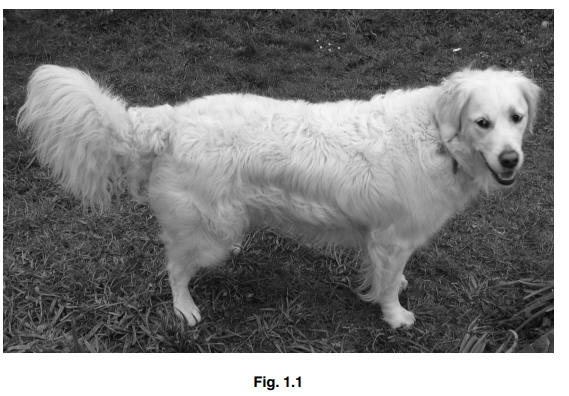
Explain how the principles of artificial selection would have been used to produce golden retrievers with the characteristics required for a guide dog.[4]
(b) The domestic dog, Canis familiaris, is found worldwide. It is able to breed with all other members of the genus to form fertile hybrids.
The distribution of some of the species belonging to the genus Canis is shown in Fig. 1.2.
The dingo and the grey wolf species have distinct ranges but the ranges of three species of jackal overlap in East Africa.
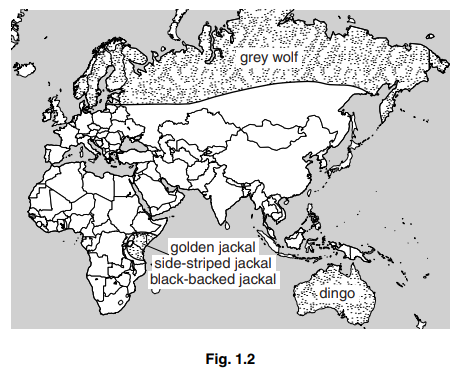
Table 1.1 shows whether members of different species of the genus Canis are able to breed with each other.
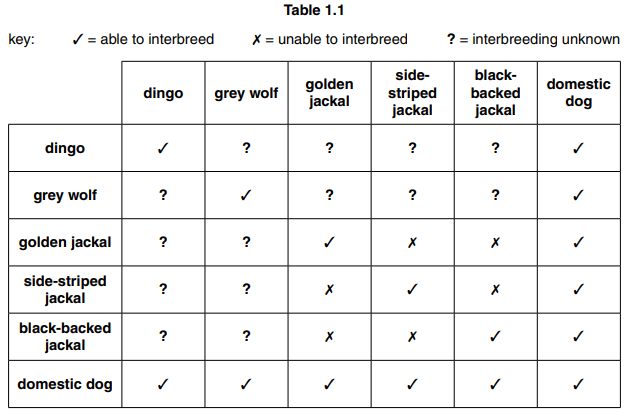
(i) Suggest the type of isolating mechanism preventing:[2]
- the three species of jackal interbreeding
- the dingo mating with all the other members of the genus Canis apart from the domestic dog.
(ii) Using the information in Fig. 1.2 and Table 1.1, state:[2]
- one reason why the members of the genus Canis could be described as one species
- one reason why they should be described as separate species.
[Total: 8]
Answer/Explanation
Ans:
1 (a) 1 (ideal characteristics) selected by humans/AW ;
2 one example of features ; e.g. calm temperament/obedient/intelligent
3 allowed to mate/bred together ;
4 offspring with ideal characteristics chosen to mate ;
5 over (many) generations ;
6 allele frequency (for ideal characteristics) increases ;
7 directional selection ;
(b) (i) jackal
behavioural/reproductive/AW ;
dingo
geographical/AW ;
(ii) one species
all breeds form fertile offspring with (domestic) dog ;
separate species
idea of different types of jackal do not interbreed (to produce fertile offspring) ;
Question
(a) List three reasons why it is important to conserve endangered plant species. [3]
1
2
3
(b) The tree Vatica guangxiensis is an endangered species. Only three wild populations exist, all in south-western China. Conservation of this species began in the 1980s. Conservation methods included attempts to preserve the habitat of the wild populations and the establishment of a fourth population in the Xishuangbanna Tropical Botanical Garden.
In 2002, the genetic diversity of each of the four populations was assessed. This was done by testing samples of DNA from a number of individuals.
- Twenty different regions of DNA were investigated, using electrophoresis.
- For each population, the percentage of samples that showed differences in the DNA structure, shown by different bands on the DNA ‘fingerprint’, was calculated.
- This figure was recorded as the percentage of polymorphic bands.
The greater the percentage of polymorphic bands, the greater the genetic diversity in the population.
Table 4.1 shows the results.
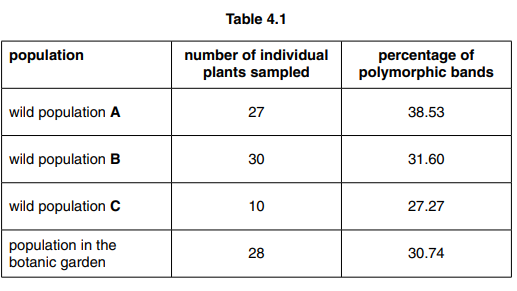
(i) With reference to Table 4.1, compare the genetic diversity of the population of V. guangxiensis in the botanic garden with the genetic diversity of the three wild populations.[2]
(ii) Suggest explanations for the relatively low percentage of polymorphic bands recorded in wild population C.[2]
(iii) Explain why high genetic diversity is important for a species.[2]
(iv) The Xishuangbanna Tropical Botanical Garden is located only tens of kilometres from the habitats of the wild populations of V. guangxiensis.
Suggest how this may help with the long-term conservation of this species.[2]
(c) Seed banks also have an important role in the conservation of endangered plant species.
(i) Explain why storing seeds may be a more successful method of conservation than maintaining a population of growing plants.[2]
(ii) Suggest why a sample of each type of seed stored in a seed bank is germinated every few years.[2] [Total: 15]
Answer/Explanation
Ans:
4 (a) 1 maintains biodiversity ;
2 maintain, genetic diversity/genetic variation/gene pool ;
3 (loss of a species) may affect food, chains/webs ;
4 use by humans ; e.g. medical use/building materials/food
5 (eco)tourism ;
6 ethical/moral/aesthetic, reasons ;
(b) (i) assume answer refers to the botanic garden population unless otherwise stated
statement about position relative to A, B or C ; e.g. closest to B/lower than A and B/higher than C
use of comparative figures ; e.g. 30.74 plus one other
(ii) 1 small number/(only) 10, sampled ;
2 some, variants /alleles, were not included in the sample ;
3 C may be smaller than the other populations ;
4 C may have developed from only a small number of original plants ;
5 (so) only a small number of, alleles/ variants, (present in the original population) ; A small gene pool/less genetic diversity
(iii) 1 idea of better chance of survival in changing conditions ;
2 example of change ; e.g. climatic /increased competition/new disease/ new pest
3 less chance of, two harmful recessive alleles coming together/ inbreeding depression ;
(iv) 1 (environmental) conditions similar to those in the, wild/natural habitat ;
2 within pollination distance/AW ;
3 ref. to possible reintroduction of plants to the wild ;
(c) (i) assume answer refers to the seeds unless otherwise stated
1 idea that seeds are small and easier to store ;
2 seeds can be stored for a long time ;
3 little maintenance required ;
4 less prone to, disease/being eaten ;
5 seeds can be stored anywhere in the world ;
(ii) 1 to check that seeds are still, viable/able to germinate ;
2 to produce new plants from which fresh seeds can be collected ;
3 to, find/ verify, conditions for breaking seed dormancy (should plants be needed) ;
Question
(a) Explain the meaning of the term biodiversity. [2]
(b) The Javan gibbon, Hylobates moloch, is an endangered species.
Fig. 5.1 shows a female Javan gibbon with an infant.
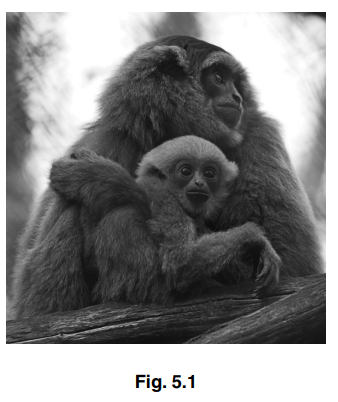
Javan gibbons live in fragmented patches of undisturbed forest in western Java, Indonesia. Habitat loss has reduced the population of wild gibbons to around 4500 individuals.
(i) Suggest why the separation of their habitat into small fragments, rather than a single large area, poses a threat to the long-term survival of this species.[3]
(ii) Several zoos in Java keep Javan gibbons, but few of these are involved in breeding programmes.
Suggest how, other than through captive breeding programmes, zoos in Java could contribute to the conservation of the Javan gibbon. [3] [Total: 8]
Answer/Explanation
Ans:
5 (a) 1 diversity of, habitats /ecosystems ;
2 number of different species ;
3 genetic diversity within a species ;
(b) (i) 1 less choice of mates ;
2 could lead to inbreeding ;
3 inbreeding depression/ decrease in hybrid vigour ;
4 decrease in, genetic variation/ heterozygosity ; A smaller gene pool
5 ref. to possible difficulties in finding enough food ;
6 idea that small areas are more vulnerable to damage than larger ones ;
7 more easily exposed to danger outside area ;
(ii) 1 educate people about the gibbons ;
2 can research gibbons to find about their, behaviour/ habitat requirements;
3 ref. to health care ;
4 adequate food ;
5 AVP ; e.g. fundraising for conservation projects in the wild/ protection from predators or hunters
